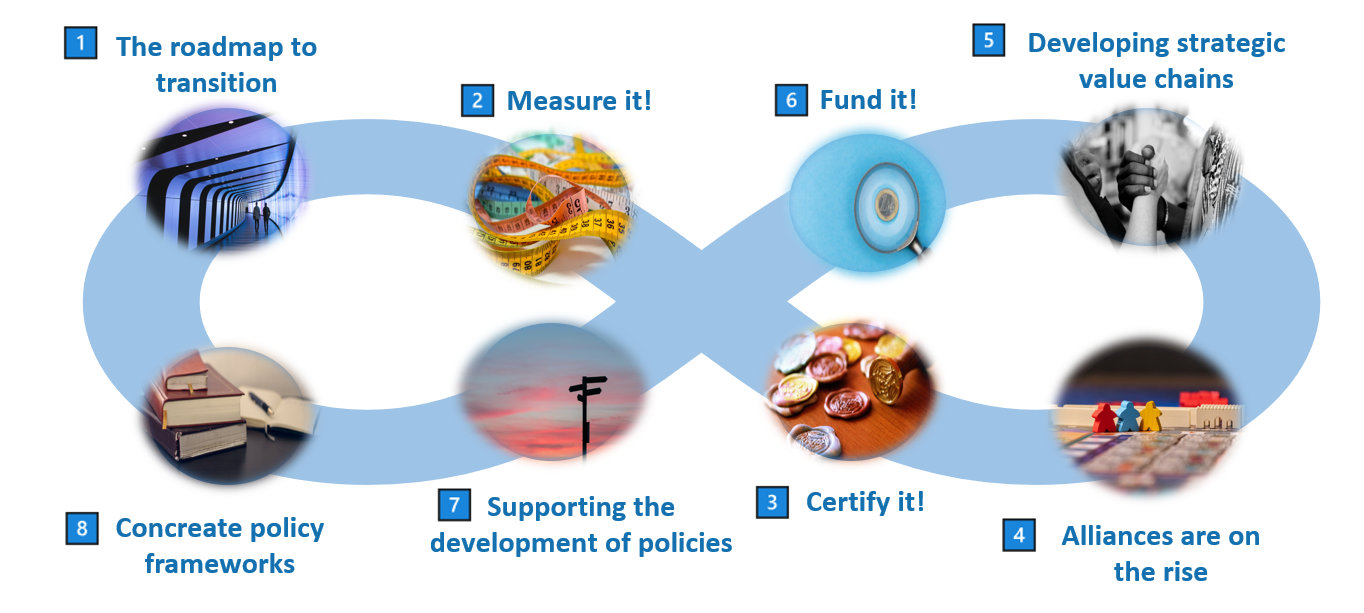What is the strategic path to net zero?
In 2025
-

The roadmap to transition
From the SDGs Roadmap to Sectoral Roadmaps to the Transition Pathway for the Chemical Industry. It reflects the different initiates the industry underwent in the last years to set its transition in motion.
Despite the fact that the new European Commission’s Omnibus Proposal scraps sector-specific standards, it is yet worthwhile to have defined and keep focusing on the execution of a well-crafted strategic roadmap. Achieving clear specific milestones within a value chain makes a vision come to fruition beyond its reporting. -

Measure it!
In the world of corporate sustainability the path forward involves creating environmental, social and economic value over the long term through sustainability-oriented strategies, business models, investments and management tools. There are different ways to ensure companies can measure progress and track relevant goals, being one of them using environmental sustainability metrics.
The undeniable need for sustainable development generated the establishment of an array of sustainability frameworks that have been designed to be the guidance for all organizations to move the world towards more sustainable future, being able to measure progress in an accreditable way.
But now in 2025 thanks to the Omnibus proposal with some major regulatory rollbacks for corporate sustainability in Europe, the reporting landscape has just changed dramatically. -

Certify it!
Nowadays, companies not only need to seek innovations, technologies deployments and value chain collaborations as it has never been attempted in history, they would also need to certify every step of the journey to ensure legitimacy. The proliferation of independent, science-based body’s is in the rise. Moreover, the array of specialized services goes from setting emissions reduction targets to audit the different value chains involved in each specific solution.
-

Alliances are on the rise
The recent announcement of chemical plant closures in the Port of Rotterdam has sent shockwaves through the sector. This is a stark reminder that the time for action is now, but not at the individual level, true progress requires collective effort.
It is through collaboration that companies achieve efficiency and resilience. We cannot afford to lose any more key players in this critical sector. Instead, we must ask: How can industrial leaders, who recognize the value of alliances, unite with governments, political parties, and other stakeholders to advance a shared decarbonization agenda?
The moment has come for industrial alliances to step up and drive the acceleration of implementation plans. Could a Low-Carbon Industry Alliance be the answer, a partnership that safeguards Europe's industrial future while meeting ambitious sustainability goals? -

Developing strategic value chains
A value chain is a business model that describes the full range of activities needed to create a product or service, from the raw materials to the sales and marketing activities, covering manufacturing, operations and logistics.
In his 1985 book Competitive Advantage, Porter asserts that value chain analysis is directly linked to competitive advantage. Nowadays, industries must adapt and modernise if they are to stay ahead of the game. Industrial systems rely on proper working value chains, hence, a strategically value chain results from a prioritisation effort in order to effectively maximize the value versus the endeavours required to improve the value offering to the customers.
How to develop strategic value chains? By Important Projects of Common European Interest, for example.
IPCEIs began supporting infrastructure projects connecting countries, after that starting point, in recent times, three research, development and innovation IPCEIs have been approved. Microelectronics and battery value chains are the first two strategic areas being granted under the IPCEI framework. Hydrogen technologies and systems and Low-Carbon Industries have been identified as two out of six additional key strategic value chains for joint or coordinated investments and actions. -

Fund it!
My takeaway about the cost of the transition is threefold. Inflow of billions of dollars is plainly needed, a notable increase in the investment percentage is expected and surely the cost of production is going to increase in a significant proportion. A sustainable transition to net zero can only be achieved if there is sufficient inflow of capital, and by now we should realize that public capital alone won’t be enough. Therefore, mobilizing private capital becomes crucial. Moreover, private capital is going to have to take a big step up, and quickly. There is a need to bring together different sources of public and private capital in technology-specific financing blueprints.
Having a clear strategic roadmap and adhering to independent frameworks on top of having already started the company’s own small scale investment activity, are steps to take into consideration prior to start collaborating with other investment parties aiming to scale up. -

Supporting the development of policies
Success in the transition to carbon neutrality depends on the coordinated engagement of all relevant actors. However, instead of ensuring the predictable deployment of existing green technologies and investments in research and innovation, industry-wide efforts remain fragmented.
Over the next decade, organized and well-supported alliances—bringing together industrial partners along with public and social stakeholders—will be key in driving progress. In this regard, I see two areas facing significant synergistic gaps: circularity and carbon capture, utilization, and storage (CCUS). -

Concreate policy frameworks
From the New Industrial Deal in 2022 to the Clean Industrial Deal and the 1st Omnibus package in 2025, simplification and harmonization has been a common thread to boost the ambitioned low-carbon economy in EU.
And we continue to witness industry leaders engaging with policymakers in strategic dialogues to turn ambition into concrete solutions that avoid collapse and reverse the plant closure lately announced.

